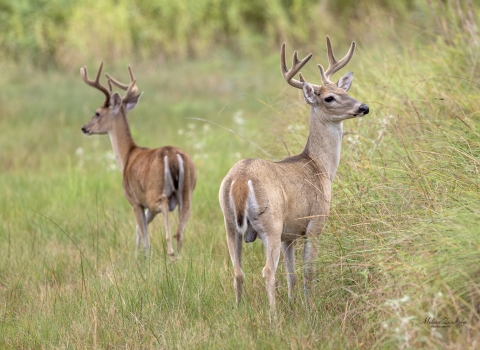Visit Us
National wildlife refuges offer us all a chance to unplug from the stresses of daily life and reconnect with our natural surroundings. Whether walking trails or fishing the lake, the sounds and sights of Supawna’s woods lend serenity to the soul.
Location and Contact Information
About Us
Supawna Meadows NWR is a stunning location any time of year. The 2,800-acre site is located just north of the Salem River and is part of the internationally recognized Delaware River estuary. Its central location and predominance of brackish tidal marsh make it a critical stop for migratory birds resting and feeding each spring and fall. It is also important foraging territory for nesting birds, especially those from nearby Pea Patch Island (see Fort Mott). Supawna’s grassland habitats are managed to attract and maintain populations of American Woodcock and American Kestrel. In addition, sandpipers and other shorebirds use the refuge marshes as a feeding area during the summer and during the migration seasons. Although the Refuge's office is currently closed, feel free to explore the Grassland Trail from the large parking area on Lighthouse Road or proceed to the corner of Christmas Tree Lane and Fort Mott Road to begin the Forest Habitat Trail.
What We Do
Wildlife conservation is at the heart of the National Wildlife Refuge System. It drives everything on U.S. Fish and Wildlife Service lands and waters managed within the Refuge System, from the purposes for which a national wildlife refuge national wildlife refuge
A national wildlife refuge is typically a contiguous area of land and water managed by the U.S. Fish and Wildlife Service for the conservation and, where appropriate, restoration of fish, wildlife and plant resources and their habitats for the benefit of present and future generations of Americans.
Learn more about national wildlife refuge is established to the recreational activities offered to the resource management tools used. Using conservation best practices, the Refuge System manages Service lands and waters to help ensure the survival of native wildlife species.
Our Species
Supawna Meadows is a crucial habitat for hundreds of plant and animal species, such as American Woodcock and the Northern Long-eared Bat.
Get Involved
"Whether you want to further conservation, learn more about nature or share your love of the outdoors, you’ve come to the right place. National wildlife refuges provide many opportunities for you to help your community and fish and wildlife by doing what you love.
National wildlife refuges partner with volunteers, youth groups, landowners, neighbors and residents of urban and coastal communities to make a lasting difference.
Find out how you can help make American lands healthier and communities stronger while doing something personally satisfying.
Projects and Research
Refuges deploy a host of scientifically sound management tools to address biological challenges. These tools span active water management to wilderness character monitoring, all aimed at ensuring a balanced conservation approach to benefit both wildlife and people. At this field station our conservation tool box includes:
Planning
Habitat Restoration
Conservation Easements
Compatibility Determinations
Education & Outreach
Invasive Species
Land Acquisition
Wildlife Health
